| Pages:
1
..
19
20
21
22
23 |
MineMan
National Hazard
   
Posts: 996
Registered: 29-3-2015
Member Is Offline
Mood: No Mood
|
|
Why so much love for DBX-1? It’s VOD is high, it’s lead free but is it not still pretty sensitive?
|
|
|
snooby
Hazard to Self
 
Posts: 88
Registered: 24-5-2013
Member Is Offline
Mood: No Mood
|
|
https://www.researchgate.net/publication/288871303_Recent_Ad...
This article include some detailed info about impurities in raw nantz.
|
|
|
wessonsmith
Hazard to Others
  
Posts: 203
Registered: 15-2-2018
Location: elsewhere
Member Is Offline
|
|
Yeah, I agree. I have made some of the nitrotetrazole salts, silver(AgNTz), copper(DBX-1), and Sodium(NaNTz). I have even made the Nickel salt from
NaNTz. The Nickel looks very similar to NHN in color but will not separate out into a fine powder when suction filtered.
They are all very sensitive with NaNTz being the exception. NaNTz can't be used by itself in the Dihydtare form, it's too difficult to set off.
The nitrotetrazole salts are more stable and less reactive then Lead Azide but just as sensitive. So for those companies who use LA, DBX-1 is a
direct replacement, and no machinery changes are necessary. For the rest of us, they still don't offer any advantage over primaries like NHN and are
more expensive to manufacture.
|
|
|
wessonsmith
Hazard to Others
  
Posts: 203
Registered: 15-2-2018
Location: elsewhere
Member Is Offline
|
|
This doesn't apply to those who are manufacturing NaNTz using the 2017 Batch Method patent.
|
|
|
Microtek
National Hazard
   
Posts: 827
Registered: 23-9-2002
Member Is Offline
Mood: No Mood
|
|
I have experimented with the complexes in the "Green primaries" paper (transition metal complexes with nitrotetrazole amine and water). They are about
equivalent with NHN in sensitivity and power, but makes DDT more reliably.
|
|
|
Mychemlife
Harmless

Posts: 8
Registered: 24-10-2017
Member Is Offline
Mood: No Mood
|
|
Has anyone ever crystalized out any Na,(NTZ)
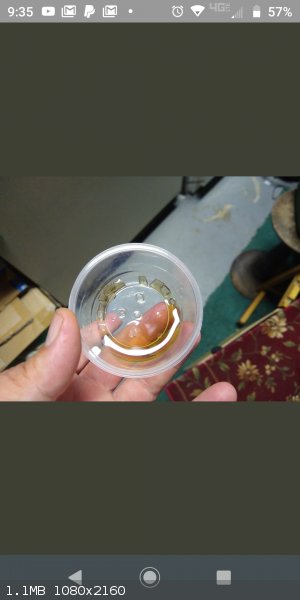
|
|
|
snooby
Hazard to Self
 
Posts: 88
Registered: 24-5-2013
Member Is Offline
Mood: No Mood
|
|
Since there are sooo many synths about nant, what is your favoriete? The facile methode give me a very yellow end product. Still kt works, but not
like this: https://youtu.be/U-1bNouTHhQ
My solution Just turns green.
Edit: i usde this one: https://patents.google.com/patent/US9598380B2/en
I notice a lot of red Times, no maybe to fast addition rate waht explanins the color.
[Edited on 4-11-2019 by snooby]
|
|
|
fusso
International Hazard
    
Posts: 1922
Registered: 23-6-2017
Location: 4 ∥ universes ahead of you
Member Is Offline
|
|
Great crystals!!!
|
|
|
snooby
Hazard to Self
 
Posts: 88
Registered: 24-5-2013
Member Is Offline
Mood: No Mood
|
|
Whats your method of maling the nantz and het the clear crystals?
|
|
|
B.D.E
Hazard to Self
 
Posts: 97
Registered: 5-8-2019
Member Is Offline
Mood: Oscillating
|
|
nevermind, please delete.
apologies.
[Edited on 14-3-2020 by B.D.E]
|
|
|
Etanol
Hazard to Others
  
Posts: 126
Registered: 27-2-2012
Member Is Offline
Mood: No Mood
|
|
How to prepare the NH4-nitrotetrazole from Na-nitrotertazole?
Na-NTz+H2SO4=>NTz ?
NTz+NH3 (water)=>NH4NTz ?
Is exist the short way?
I wish green primaryes)
|
|
|
NeonPulse
Hazard to Others
  
Posts: 417
Registered: 29-6-2013
Location: The other end of the internet.
Member Is Offline
Mood: Isolated from Reality! For Real this time....
|
|
Sure have. But via recrystallising crude product in minimal Water first and second from Acetone. The greenish tint was replaced by Snow White colour.
These crystals you have look very nice and quite well formed. Nice job.
|
|
|
B(a)P
International Hazard
    
Posts: 1110
Registered: 29-9-2019
Member Is Offline
Mood: Festive
|
|
Yesterday I conducted a synthesis of 5-ATZ. I have done this reaction 3 other times, always following the Engager method, starting with aminoguanidine
bicarbonate, presented earlier in this thread. The only way I deviate from Engagers write up is to add sodium carbonate until my solution is at pH 5.5
rather than adding the exact mass presented in the paper. Each time my yield of 5-ATZ has been around 70 to 80% based on aminoguanidine bicarbonate.
This time the changes in colour that I noted on my previous attempts did not quite match up. I also needed less sodium carbonate than I had previously
used. I didn't question this as much as I should have.
At the completion of reflux I adjusted the pH to 3 and left the solution to cool.
After cooling no product was visible, which is normal given 5-ATZ readily produces supersaturated solutions. I tried agitating, but this did not work.
I drew off 3 mls and warmed it on an evaporating dish to produce a seed crystal then inserted that into the main solution. After about 8 hours a small
mass of needle like crystals precipitated. At this point I stopped and reviewed what I had done. I reviewed my notes and other than the differences
mentioned above I couldn't see where I had gone wrong. I tried checking my pH and my meter was toast. I checked it with indicator paper and found it
to be at around 1! It seems my pH meter was on its last legs during the synthesis and so I likely refluxed at a less than optimal pH. The
crystallisation would also have occurred at a pH that was sub-optimal, though I understand this is not so critical as the pH for the reflux.
My question is what have I ended up with? I have done some research and can't find much on side products that might dominate at lower temperates.
Yield is very low. My crystalline product is transparent, colourless and needle like to 10 mm in length. For scale the stir bar is 25 mm in length.
The melting point of the product seems about right for 5-ATZ and it decomposes at about the right temperature in a way I would expect it to. My
thoughts are a very low yield and as a result the product has crystallised very slowly. Does anyone have any resources that go into depth on the side
reactions that occur for this reaction? Thanks in advance for any assistance!
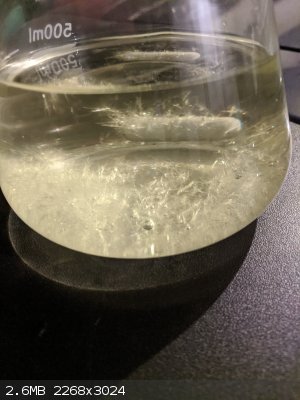 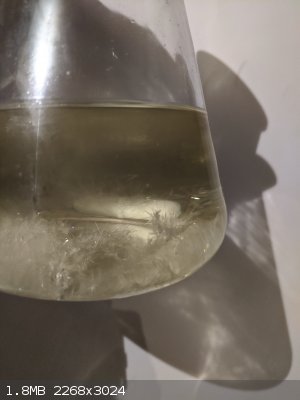
|
|
|
B(a)P
International Hazard
    
Posts: 1110
Registered: 29-9-2019
Member Is Offline
Mood: Festive
|
|
Cadmium nitrotetrazole
0.5 g of cadmium was dissolved in 1.5 g of 70 percent HNO3 and a little dH2O
The cadmium nitrate was added to a solution of 0.5 g of nitrotetrazole in 2 ml dH2O.
A white precipitate of cadmium nitrotetrazole (CdNTZ) formed immediately with a slight exotherm.
On drying the precipitate shrunk in size considerably.
The CdNTZ was readily soluble in water.
CdNTZ is slightly friction sensitive and moderately impact sensitive.
CdNTZ is sensitive to direct and indirect heating and donates before melting in amounts almost too small to see.
|
|
|
pdb
Hazard to Self
 
Posts: 70
Registered: 8-4-2004
Member Is Offline
Mood: No Mood
|
|
Question about NaNT purification
I refer to "Facile method for preparation of NaNT" (US9,598,380). It works well and is indeed very easy. But I am intrigued by the 1:2 molar ratio of
5-AT to NaNO2: this means that if one mole of Na gives NaNT, another mole of Na goes into the solution and pollutes it. But in what form? NaNO3, or an
excess of NaNO2, or what else? We should know this before trying to find a method to purify NaNT. Does anyone know how to write the reaction between
5-AT, NaNO2 and HNO3?
[Edited on 7-5-21 by pdb]
|
|
|
pdb
Hazard to Self
 
Posts: 70
Registered: 8-4-2004
Member Is Offline
Mood: No Mood
|
|
Advice from someone who has successfully prepared crystalline DBX-1
I have prepared DBX-1 according to Fronabarger twice, with similar results. I have no doubt about the nature of the product, which deflagrates on
contact with flame and detonates on heat or under light confinement. On the other hand, I observe that the product, when dried on a filter, appears as
lumps, which leave a fine sticky dust on the finger when touched. Under the microscope, this powder appears amorphous. Moreover, its density is low,
and even under high pressure it is difficult to reduce its volume: for the same weight, it is 4 to 5 times more voluminous when pressed than AgN3 for
example. Also, I wonder if I missed the crystallisation step: according to Fronabarger, at about one third of the addition of the ascorbate, the
product starts to precipitate and the solution takes on a rusty colour within a few minutes. I have observed these changes, but still my DBX-1 appears
amorphous, and in this form I do not see how it could replace Pb(N3)2 according to the drop-in replacement principle.
Also, I would be interested in having someone who has obtained DBX-1 in crystalline form look at the attached photos to tell me if any differ from
their own experience. Thank you!
(sorry, the pictures are in reverse order)
(the microscope pics are 1 mm in lenth)
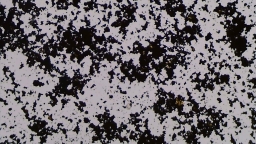 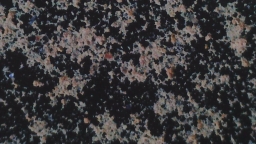 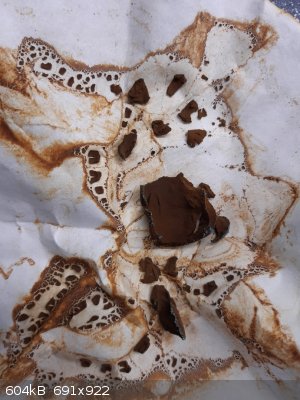 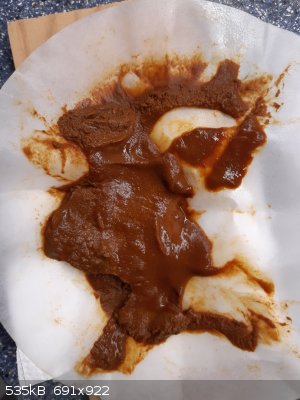 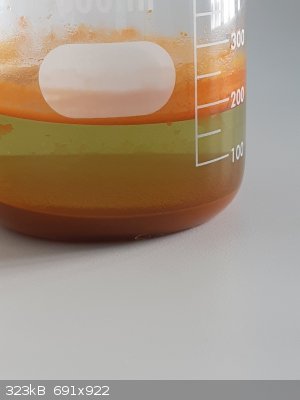 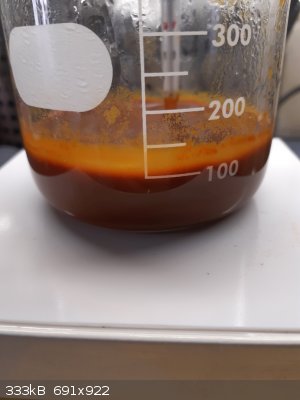 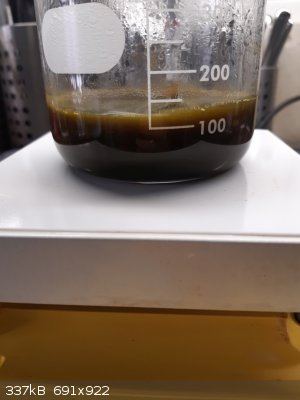 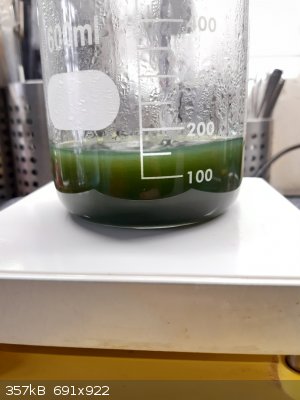 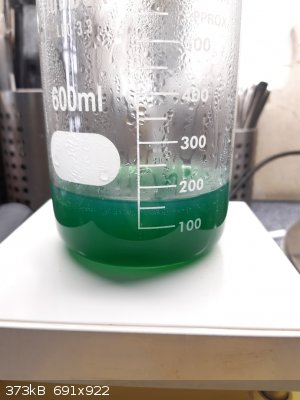 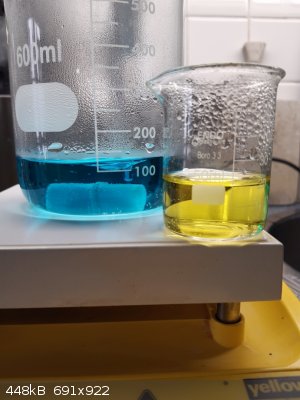
[Edited on 11-5-21 by pdb]
|
|
|
DBX Labs
Hazard to Self
 
Posts: 57
Registered: 24-12-2020
Member Is Offline
|
|
From my experience making DBX-1, I'll get a near identical amorphous brown sludge most every time I run from scratch. The sludge dries into chunks
just like yours that are flame sensitive and detonate when confined and heated. However, I have never been able to get this first product to detonate
confined with a fuse, even as a powder.
What I've found and and have yet to publish in a video is that when I've taken a small amount (~2-3 grams) of this amorphous product and fed it into a
repeated synthesis from scratch, the impure DBX-1 present in the first product catalyzes the formation of much more visible DBX-1 crystals that are
red rather than brown. Additionally, it appears much less gelatinous sludge remains intermixed with the product in this case.
Hope this helps.
|
|
|
pdb
Hazard to Self
 
Posts: 70
Registered: 8-4-2004
Member Is Offline
Mood: No Mood
|
|
Quote: Originally posted by DBX Labs  | | the impure DBX-1 present in the first product catalyzes the formation of much more visible DBX-1 crystals that are red rather than brown.
Additionally, it appears much less gelatinous sludge remains intermixed with the product in this case. |
This effect is reported by Ford (from line 46). I'll give it a try myself.
Attachment: 2015 DBX-1-Ford.pdf (929kB)
This file has been downloaded 456 times
|
|
|
FanofYellow
Harmless

Posts: 10
Registered: 24-1-2022
Location: GMT-5
Member Is Offline
|
|
Hi guys, if you're following DBX labs (ReactiveChem) procedure with NaNO2+H2SO4, make sure to keep your temps within +5c of specified temperature (65
degrees) or you're gonna get some micro detonations and have a scary time.
First one scared the hell out of me. Thought my Chinaware was preparing to shatter, did a quick recon and just about the time I put the pieces
together and realized what was happening the SECOND one happened. This occurred with the following setup:
Solution 1:
2g 5-ATZ
1.36mL H2SO4 (93%)
10mL Water
Solution 2 (to be added to solution 1):
5.68g NaNO2
20mL Distilled Water
Temperature was about 72 degrees when I did maybe the fifth 1.5mL addition of solution 2 into solution 1. Being done on a round bottom flash inside of
my stirring heating mantle.
edit: was also blowing air into reaction flask to help clear evolved NO2. Maybe that contributed to the micro detonations
[Edited on 12-2-2022 by FanofYellow]
|
|
|
FanofYellow
Harmless

Posts: 10
Registered: 24-1-2022
Location: GMT-5
Member Is Offline
|
|
What do you guys think? NaNTZ synthesis I panicked over yesterday. I don't know if that's the final product though, methinks I might have made sodium
nitrate, those big crystals decompose into NOx on heating, but they do crackle
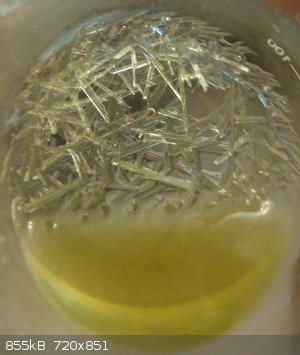
|
|
|
B(a)P
International Hazard
    
Posts: 1110
Registered: 29-9-2019
Member Is Offline
Mood: Festive
|
|
That kind of looks like 5 aminotetrazole. Nitrotetrazole should do not then crackle.
|
|
|
FanofYellow
Harmless

Posts: 10
Registered: 24-1-2022
Location: GMT-5
Member Is Offline
|
|
Quote: Originally posted by FanofYellow  | | What do you guys think? NaNTZ synthesis I panicked over yesterday. I don't know if that's the final product though, methinks I might have made sodium
nitrate, those big crystals decompose into NOx on heating, but they do crackle |
My beautiful crystals nooooo.... Instead of crackling on heating my (formerly) beautiful crystals turned to completely nonflammable white powder.
Testing my end product with Silver Nitrate solution precipitated out some insoluble white stuff which pretty much confirms I've made sodium sulfate...
Oh well, back to the bench to try again.
|
|
|
B(a)P
International Hazard
    
Posts: 1110
Registered: 29-9-2019
Member Is Offline
Mood: Festive
|
|
Quote: Originally posted by FanofYellow  | Hi guys, if you're following DBX labs (ReactiveChem) procedure with NaNO2+H2SO4, make sure to keep your temps within +5c of specified temperature (65
degrees) or you're gonna get some micro detonations and have a scary time.
First one scared the hell out of me. Thought my Chinaware was preparing to shatter, did a quick recon and just about the time I put the pieces
together and realized what was happening the SECOND one happened. This occurred with the following setup:
Solution 1:
2g 5-ATZ
1.36mL H2SO4 (93%)
10mL Water
Solution 2 (to be added to solution 1):
5.68g NaNO2
20mL Distilled Water
Temperature was about 72 degrees when I did maybe the fifth 1.5mL addition of solution 2 into solution 1. Being done on a round bottom flash inside of
my stirring heating mantle.
edit: was also blowing air into reaction flask to help clear evolved NO2. Maybe that contributed to the micro detonations
[Edited on 12-2-2022 by FanofYellow] |
I only just read this first post properly. You should not get detonations with this reaction, nor should it be so touchy within 5C of the recommended
temperature. You should have added the ATZ solution to the nitrite, not the other way around, that is your problem.
|
|
|
magneet
Harmless

Posts: 19
Registered: 30-12-2007
Location: on a forum somewhere
Member Is Offline
Mood: lurking mostly
|
|
| Quote: | Question about NaNT purification
I refer to "Facile method for preparation of NaNT" (US9,598,380). It works well and is indeed very easy. But I am intrigued by the 1:2 molar ratio of
5-AT to NaNO2: this means that if one mole of Na gives NaNT, another mole of Na goes into the solution and pollutes it. But in what form? NaNO3, or an
excess of NaNO2, or what else? We should know this before trying to find a method to purify NaNT. Does anyone know how to write the reaction between
5-AT, NaNO2 and HNO3?
[Edited on 7-5-21 by pdb] |
According to this patent:
https://patents.google.com/patent/US9718791B2/en
Here the slight excess of nitrite is added to control PH somewhat during the reaction in the "continuous flow system" (not to be confused with the
batch method).
From that same patent:
| Quote: | | In the embodiments where the nitrite reactant is added in excess for pH control, the excess nitrite is still present in the reactant mixture 26 after
the substitution reaction has reached completion. To remove the excess nitrites, additional acid may be added to the reactant mixture 26 at any one or
more of various suitable locations, which include but are not limited to a late stage of the reaction zone 28 at a point where the reaction is nearing
or at completion; at the point where the reactant mixture 26 exits the processing zone 18; and/or after the reactant mixture 26 is being held the
receiving vessel. The excess nitrite and acid forms N2O3, which then bubbles out of the reactant mixture 26, thus removing the excess nitrite as a
potential impurity in the final product. |
Looking at the table of impurities in that patent NaNO2/NaNO3 are the main impurities I guess.
So since this method uses the same reactants , if using the batch method with
nitric acid it should be purified like this right?: 2HNO3 + 2NaNO2 → N2O3 + 2NaNO3 + H2O adding HNO3 until bubbling stops? , if using the batch method with
nitric acid it should be purified like this right?: 2HNO3 + 2NaNO2 → N2O3 + 2NaNO3 + H2O adding HNO3 until bubbling stops?
Since they use the end product to synth BNCP directly I assume the NaNO3 doesn't play a big role? like for example by the addition of AgNO3 solution?
Can anyone tell if the extraction method with acetone is sufficient to remove the NaNO3 impurity ? I did a batch with CUNT method years ago and didn't
find many residu when i did acetone extraction on evaporated NaNT solution left after CuO removal step.
Hi,
|
|
|
dettoo456
Hazard to Others
  
Posts: 166
Registered: 12-9-2021
Member Is Offline
|
|
@magneet There shouldn’t be any (if there is it’d be negligible) NaNO3 after Acetone extraction. The NaNTz has good solubility compared to the
NaNO3 in Acetone; vice-versa with H2O. If you need a really pure product then routing through with AgNTz can work.
|
|
|
| Pages:
1
..
19
20
21
22
23 |